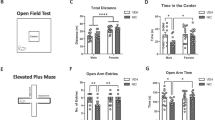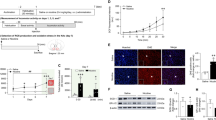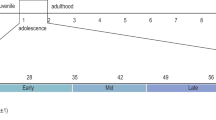Abstract
Epidemiological studies have shown that adolescent smoking is associated with health risk behaviors, including high-risk sexual activity and illicit drug use. Using rat as an animal model, we evaluated the behavioral and biochemical effects of a 4-day, low-dose nicotine pretreatment (60 μg/kg; intravenous) during adolescence and adulthood. Nicotine pretreatment significantly increased initial acquisition of cocaine self-administration, quinpirole-induced locomotor activity, and penile erection in adolescent rats, aged postnatal day (P)32. These effects were long lasting, remaining evident 10 days after the last nicotine treatment, and were observed when nicotine pretreatment was administered during early adolescence (P28–31), but not late adolescence (P38–41) or adulthood (P86–89). Neurochemical analyses of c-fos mRNA expression, and of monoamine transmitter and transporter levels, showed that forebrain limbic systems are continuing to develop during early adolescence, and that this maturation is critically altered by brief nicotine exposure. Nicotine selectively increased c-fos mRNA expression in the nucleus accumbens shell and basolateral amygdala in adolescent, but not adult animals, and altered serotonin markers in these regions as well as the prefrontal cortex. Nicotine enhancement of cocaine self-administration and quinpirole-induced locomotor activity was blocked by co-administration of WAY 100 635 (N-{2-[4-(2-methoxyphenyl)-1-piperazinyl] ethyl}-N-(2-pyridinyl)cyclohexanecarboxamide), a selective serotonin 1A (5-HT1A) receptor antagonist. Early adolescent pretreatment with the mixed autoreceptor/heteroceptor 5-HT1A receptor agonist, 8-OH-DPAT, but not the autoreceptor-selective agonist, S-15535, also enhanced quinpirole-induced locomotor activation. Nicotine enhancement of quinpirole-induced penile erection was not blocked by WAY 100 635 nor mimicked by 8-OH-DPAT. These findings indicate that early adolescent nicotine exposure uniquely alters limbic function by both 5-HT1A and non-5-HT1A receptor mechanisms.
Similar content being viewed by others
Log in or create a free account to read this content
Gain free access to this article, as well as selected content from this journal and more on nature.com
or
References
Abreu-Villaca Y, Seidler FJ, Qiao D, Tate CA, Cousins MM, Thillai I et al (2003). Short-term adolescent nicotine exposure has immediate and persistent effects on cholinergic systems: critical Periods, patterns of exposure, dose thresholds. Neuropsychopharmacology 28: 1935–1949.
Abreu-Villaça Y, Filgueiras CC, Guthierrez M, Medeiros AHD, Mattos MA, Pereira MDS et al (2010). Exposure to tobacco smoke containing either high or low levels of nicotine during adolescence: differential effects on choline uptake in the cerebral cortex and hippocampus. Nicotine Tob Res 12: 776–780.
Adriani W, Granstrem O, Macri S, Izykenova G, Dambinova S, Laviola G (2004). Behavioral and neurochemical vulnerability during adolescence in mice: studies with nicotine. Neuropsychopharmacology 29: 869–878.
Adriani W, Spijker S, Deroche-Gamonet V, Laviola G, Le Moal M, Smit AB et al (2003). Evidence for enhanced neurobehavioral vulnerability to nicotine during periadolescence in rats. J Neurosci 23: 4712–4716.
Andersen SL, Thompson AT, Rustein M, Hostetter JC, Teigher MH (2000). Dopamine receptor pruning in prefrontal cortex during the periadolescent period in rats. Synapse 37: 167–169.
Azam L, Chen Y, Leslie FM (2007). Developmental regulation of nicotinic acetylcholine receptors within midbrain dopamine neurons. Neuroscience 144: 1347–1360.
Bagdy G, To CT (1997). Comparison of relative potencies of i.v. and i.c.v. administered 8-OH-DPAT gives evidence of different sites of action for hypothermia, lower lip retraction and tail flicks. Eur J Pharmacol 323: 53–58.
Belluzzi JD, Lee AG, Oliff HS, Leslie FM (2004). Age-dependent effects of nicotine on locomotor activity and conditioned place preference in rats. Psychopharmacology 174: 389–395.
Belluzzi JD, Wang R, Leslie FM (2005). Acetaldehyde enhances acquisition of nicotine self-administration in adolescent rats. Neuropsychopharmacology 30: 705–712.
Benoit-Marand M, O’Donnell P (2008). D2 dopamine modulation of corticoaccumbens synaptic responses changes during adolescence. Eur J Neurosci 27: 1364–1372.
Biederman J (2005). Attention-deficit/hyperactivity disorder: a selective overview. Biol Psychiatry 57: 1215–1220.
Biederman J, Monuteaux MC, Mick E, Wilens TE, Fontanella JA, Poetzl KM et al (2006). Is cigarette smoking a gateway to alcohol and illicit drug use disorders? A study of youths with and without attention deficit hyperactivity disorder. Biol Psychiatry 59: 258–264.
Biglan A, Metzler CW, Wirt R, Ary D, Noell J, Ochs L et al (1990). Social and behavioral factors associated with high-risk sexual behavior among adolescents. J Behav Med 13: 245–261.
Brenhouse HC, Sonntag KC, Andersen SL (2008). Transient D1 dopamine receptor expression on prefrontal cortex projection neurons: relationship to enhanced motivational salience of drug cues in adolescence. J Neurosci Off J Soc Neurosci 28: 2375–2382.
Bridge JA, Iyengar S, Salary CB, Barbe RP, Birmaher B, Pincus HA et al (2007). Clinical response and risk for reported suicidal ideation and suicide attempts in pediatric antidepressant treatment: a meta-analysis of randomized controlled trials. JAMA 297: 1683–1696.
Bronisch T, Höfler M, Lieb R (2008). Smoking predicts suicidality: findings from a prospective community study. J Affect Disord 108: 135–145.
Brook JS, Balka EB, Ning Y, Brook DW (2007). Trajectories of cigarette smoking among African Americans and Puerto Ricans from adolescence to young adulthood: associations with dependence on alcohol and illegal drugs. Am J Addict/Am Acad Psychiatrists Alcohol Addict 16: 195–201.
Cao J, Belluzzi JD, Loughlin SE, Keyler DE, Pentel PR, Leslie FM (2007a). Acetaldehyde, a major constituent of tobacco smoke, enhances behavioral, endocrine, and neuronal responses to nicotine in adolescent and adult rats. Neuropsychopharmacology 32: 2025–2035.
Cao J, Lotfipour S, Loughlin SE, Leslie FM (2007b). Adolescent maturation of cocaine-sensitive neural mechanisms. Neuropsychopharmacology 32: 2279–2289.
Carey RJ, DePalma G, Damianopoulos E (2001). Cocaine and serotonin: a role for the 5-HT(1A) receptor site in the mediation of cocaine stimulant effects. Behav Brain Res 126: 127–133.
Chambers RA, Taylor JR, Potenza MN (2003). Developmental neurocircuitry of motivation in adolescence: a critical period of addiction vulnerability. Am J Psychiatry 160: 1041–1052.
Chen YI, Choi J, Xu H, Ren J, Andersen SL, Jenkins BG (2010). Pharmacologic neuroimaging of the ontogeny of dopamine receptor function. Dev Neurosci 32: 125–138.
Chen JC, Turiak G, Galler J, Volicer L (1997). Postnatal changes of brain monoamine levels in prenatally malnourished and control rats. Int J Dev Neurosci 15: 257–263.
Covey LS, Manubay J, Jiang H, Nortick M, Palumbo D (2008). Smoking cessation and inattention or hyperactivity/impulsivity: a post hoc analysis. Nicot Tob Res 10: 1717–1725.
Dinopoulos A, Dori IE, Parnavelas JG (1997). The serotonin innervation of the basal forebrain shows a transient phase during development. Brain Res Dev Brain Res 99: 38–52.
Dori IE, Dinopoulos A, Parnavelas JG (1998). The development of the synaptic organization of the serotonergic system differs in brain areas with different functions. Exp Neurol 154: 113–125.
Dwyer JB, McQuown SC, Leslie FM (2009). The dynamic effects of nicotine on the developing brain. Pharmacol Therap 122: 125–139.
El Mansari M, Blier P (2005). Responsiveness of 5-HT(1A) and 5-HT2 receptors in the rat orbitofrontal cortex after long-term serotonin reuptake inhibition. J Psychiatry Neurosci 30: 268–274.
Ernst M, Fudge JL (2009). A developmental neurobiological model of motivated behavior: anatomy, connectivity and ontogeny of the triadic nodes. Neurosci Biobehav Rev 33: 367–382.
Ernst M, Pine DS, Hardin M (2006). Triadic model of the neurobiology of motivated behavior in adolescence. Psychol Med 36: 299–312.
Fletcher A, Forster EA, Bill DJ, Brown G, Cliffe IA, Hartley JE et al (1995). Electrophysiological, biochemical, neurohormonal and behavioural studies with WAY-100635, a potent, selective and silent 5-HT1A receptor antagonist. Behav Brain Res 73: 337–353.
Fletcher PJ, Grottick AJ, Higgins GA (2002). Differential effects of the 5-HT(2A) receptor antagonist M100907 and the 5-HT(2C) receptor antagonist SB242084 on cocaine-induced locomotor activity, cocaine self-administration and cocaine-induced reinstatement of responding. Neuropsychopharmacology 27: 576–586.
Frantz KJ, O’Dell LE, Parsons LH (1999). The locomotor effects of quinpirole in rats depend on age and gender. Pharmacol Biochem Behav 64: 821–826.
Galindo-Charles L, Hernandez-Lopez S, Galarraga E, Tapia D, Bargas J, Garduño J et al (2008). Serotoninergic dorsal raphe neurons possess functional postsynaptic nicotinic acetylcholine receptors. Synapse 62: 601–615.
Gehricke J, Loughlin SE, Whalen CK, Potkin SG, Fallon JH, Jamner LD et al (2007). Smoking to self-medicate attentional and emotional dysfunctions. Nicotine Tob Res 9 (Suppl 4): S523–S536.
Grucza RA, Bierut LJ (2006). Co-occurring risk factors for alcohol dependence and habitual smoking: update on findings from the Collaborative Study on the Genetics of Alcoholism. Alcohol Res Health 29: 172–178.
Haddjeri N, Lavoie N, Blier P (2004). Electrophysiological evidence for the tonic activation of 5-HT(1A) autoreceptors in the rat dorsal raphe nucleus. Neuropsychopharmacology 29: 1800–1806.
Hammad TA, Laughren T, Racoosin J (2006). Suicidality in pediatric patients treated with antidepressant drugs. Arch Gen Psychiatry 63: 332–339.
Isensee B, Wittchen H, Stein MB, Höfler M, Lieb R (2003). Smoking increases the risk of panic: findings from a prospective community study. Arch Gen Psychiatry 60: 692–700.
John U, Meyer C, Rumpf H, Hapke U (2004). Smoking, nicotine dependence and psychiatric comorbidity—a population-based study including smoking cessation after three years. Drug Alcohol Depend 76: 287–295.
Kandel DB, Yamaguchi K, Chen K (1992). Stages of progression in drug involvement from adolescence to adulthood: further evidence for the gateway theory. J Stud Alcohol 53: 447–457.
Kota D, Martin BR, Robinson SE, Damaj MI (2007). Nicotine dependence and reward differ between adolescent and adult male mice. J Pharmacol Exp Therap 322: 399–407.
LaHoste GJ, Marshall JF (1992). Dopamine supersensitivity and D1/D2 synergism are unrelated to changes in striatal receptor density. Synapse 12: 14–26.
Lai S, Lai H, Page JB, McCoy CB (2000). The association between cigarette smoking and drug abuse in the United States. J Addict Dis 19: 11–24.
Lam TH, Stewart SM, Ho LM (2001). Smoking and high-risk sexual behavior among young adults in Hong Kong. J Beh Med 24: 503–518.
Larsson LG, Rényi L, Ross SB, Svensson B, Angeby-Möller K (1990). Different effects on the responses of functional pre- and postsynaptic 5-HT1A receptors by repeated treatment of rats with the 5-HT1A receptor agonist 8-OH-DPAT. Neuropharmacology 29: 85–91.
Lewinsohn PM, Rohde P, Brown RA (1999). Level of current and past adolescent cigarette smoking as predictors of future substance use disorders in young adulthood. Addiction 94: 913–921.
Mathieu-Kia AM, Pages C, Besson MJ (1998). Inducibility of c-Fos protein in visuo-motor system and limbic structures after acute and repeated administration of nicotine in the rat. Synapse 29: 343–354.
McQuown SC, Belluzzi JD, Leslie FM (2007). Low dose nicotine treatment during early adolescence increases subsequent cocaine reward. Neurotoxicol Teratol 29: 66–73.
McQuown SC, Dao JM, Belluzzi JD, Leslie FM (2009). Age-dependent effects of low-dose nicotine treatment on cocaine-induced behavioral plasticity in rats. Psychopharmacology 207: 143–152.
Mihailescu S, Palomero-Rivero M, Meade-Huerta P, Maza-Flores A, Drucker-Colín R (1998). Effects of nicotine and mecamylamine on rat dorsal raphe neurons. Eur J Pharmacol 360: 31–36.
Millan MJ, Rivet JM, Gobert A, Canton H, Veiga S, Bervoets K et al (1994). 5-HT1A receptors and the tail-flick response. VI. Intrinsic alpha 1A-adrenoceptor antagonist properties can mask the actions of 5-HT1A receptor agonists in the spontaneous tail-flick paradigm. J Pharmacol Exp Therap 269: 121–131.
Millan MJ, Rivet J, Canton H, Lejeune F, Gobert A, Widdowson P et al (1993). S 15535: a highly selective benzodioxopiperazine 5-HT1A receptor ligand which acts as an agonist and an antagonist at presynaptic and postsynaptic sites respectively. Eur J Pharmacol 230: 99–102.
Moll GH, Mehnert C, Wicker M, Bock N, Rothenberger A, Rüther E et al (2000). Age-associated changes in the densities of presynaptic monoamine transporters in different regions of the rat brain from early juvenile life to late adulthood. Dev Brain Res 119: 251–257.
Murrin LC, Sanders JD, Bylund DB (2007). Comparison of the maturation of the adrenergic and serotonergic neurotransmitter systems in the brain: implications for differential drug effects on juveniles and adults. Biochem Pharmacol 73: 1225–1236.
Newman-Tancredi A, Rivet J, Chaput C, Touzard M, Verrièle L, Millan MJ (1999). The 5HT1A receptor ligand, S15535, antagonises G-protein activation: a [35S]GTP[gamma]S and [3H]S15535 autoradiography study. Eur J Pharmacol 384: 111–121.
Olfson M, Marcus SC, Shaffer D (2006). Antidepressant drug therapy and suicide in severely depressed children and adults: a case–control study. Arch Gen Psychiatry 63: 865–872.
Palmer RHC, Young SE, Hopfer CJ, Corley RP, Stallings MC, Crowley TJ et al (2009). Developmental epidemiology of drug use and abuse in adolescence and young adulthood: evidence of generalized risk. Drug Alcohol Depend 102: 78–87.
Park MK, Belluzzi JD, Han S, Cao J, Leslie FM (2007). Age, sex and early environment contribute to individual differences in nicotine/acetaldehyde-induced behavioral and endocrine responses in rats. Pharmacol Biochem Behav 86: 297–305.
Paxinos G, Watson C (2007). The Rat Brain in Stereotaxic Coordinates. Academic Press: New York.
Pazos A, Palacios JM (1985). Quantitative autoradiographic mapping of serotonin receptors in the rat brain. I. Serotonin-1 receptors. Brain Res 346: 205–230.
Pidoplichko VI, DeBiasi M, Williams JT, Dani JA (1997). Nicotine activates and desensitizes midbrain dopamine neurons. Nature 390: 401–404.
Pradhan AAA, Cumming P, Clarke PBS (2002). [125I]Epibatidine-labelled nicotinic receptors in the extended striatum and cerebral cortex: lack of association with serotonergic afferents. Brain Res 954: 227–236.
Rocha BA, Ator R, Emmett-Oglesby MW, Hen R (1997). Intravenous cocaine self-administration in mice lacking 5-HT1B receptors. Pharmacol Biochem Behav 57: 407–412.
Rodd ZA, Bell RL, Kuc KA, Zhang Y, Murphy JM, McBride WJ (2005). Intracranial self-administration of cocaine within the posterior ventral tegmental area of Wistar rats: evidence for involvement of serotonin-3 receptors and dopamine neurons. J Pharmacol Exp Therap 313: 134–145.
Savitz J, Lucki I, Drevets WC (2009). 5-HT(1A) receptor function in major depressive disorder. Progr Neurobiol 88: 17–31.
Shearman E, Fallon S, Sershen H, Lajtha A (2008). Nicotine-induced monoamine neurotransmitter changes in the brain of young rats. Brain Res Bull 76: 626–639.
Shram MJ, Funk D, Li Z, Lê AD (2007). Acute nicotine enhances c-fos mRNA expression differentially in reward-related substrates of adolescent and adult rat brain. Neurosci Lett 418: 286–291.
Slotkin TA, MacKillop EA, Rudder CL, Ryde IT, Tate CA, Seidler FJ (2007). Permanent, sex-selective effects of prenatal or adolescent nicotine exposure, separately or sequentially, in rat brain regions: indices of cholinergic and serotonergic synaptic function, cell signaling, and neural cell number and size at 6 months of age. Neuropsychopharmacology 32: 1082–1097.
Solinas M, Scherma M, Fattore L, Stroik J, Wertheim C, Tanda G et al (2007). Nicotinic alpha 7 receptors as a new target for treatment of cannabis abuse. J Neurosci 27: 5615–5620.
Spear LP (2000). The adolescent brain and age-related behavioral manifestations. Neurosci Biobehav Rev 24: 417–463.
Tapper AR, McKinney SL, Nashmi R, Schwarz J, Deshpande P, Labarca C et al (2004). Nicotine activation of {alpha}4* receptors: sufficient for reward, tolerance, and sensitization. Science 306: 1029–1032.
Tarazi FI, Tomasini EC, Baldessarini RJ (1999). Postnatal development of dopamine D1-like receptors in rat cortical and striatolimbic brain regions: An autoradiographic study. Dev Neurosci 21: 43–49.
Tassin J (2008). Uncoupling between noradrenergic and serotonergic neurons as a molecular basis of stable changes in behavior induced by repeated drugs of abuse. Biochem Pharmacol 75: 85–97.
Thomas MJ, Kalivas PW, Shaham Y (2008). Neuroplasticity in the mesolimbic dopamine system and cocaine addiction. Br J Pharmacol 154: 327–342.
Torabi MR, Bailey WJ, Majd-Jabbari M (1993). Cigarette smoking as a predictor of alcohol and other drug use by children and adolescents: evidence of the ‘gateway drug effect’. J School Health 63: 302–306.
Uchida S, Hotta H, Kawashima K (2009). Long-term nicotine treatment reduces cerebral cortical vasodilation mediated by alpha4beta2-like nicotinic acetylcholine receptors in rats. Eur J Pharmacol 609: 100–104.
Valjent E, Mitchell JM, Besson M, Caboche J, Maldonado R (2002). Behavioural and biochemical evidence for interactions between delta 9-tetrahydrocannabinol and nicotine. Br J Pharmacol 135: 564–578.
Wagner FA, Anthony JC (2002). Into the world of illegal drug use: exposure opportunity and other mechanisms linking the use of alcohol, tobacco, marijuana, and cocaine. Am J Epidemiol 155: 918–925.
Weinberger AH, Sofuoglu M (2009). The impact of cigarette smoking on stimulant addiction. Am J Drug Alcohol Abuse 35: 12–17.
Weiser M, Reichenberg A, Grotto I, Yasvitzky R, Rabinowitz J, Lubin G et al (2004). Higher rates of cigarette smoking in male adolescents before the onset of schizophrenia: a historical-prospective cohort study. Am J Psychiatry 161: 1219–1223.
Wilens TE, Adler LA, Adams J, Sgambati S, Rotrosen J, Sawtelle R et al (2008). Misuse and diversion of stimulants prescribed for ADHD. J Am Acad Child Adolesc Psychiatry 47: 21–31.
Winzer-Serhan UH, Broide RS, Chen Y, Leslie FM (1999). Highly sensitive radioactive in situ hybridization using full length hydrolyzed riboprobes to detect alpha 2 adrenoceptor subtype mRNAs in adult and developing rat brain. Brain Res Brain Res Protocols 3: 229–241.
Winzer-Serhan UH, Leslie FM (1997). Codistribution of nicotinic acetylcholine receptor subunit α3 and α4 mRNAs during rat brain development. J Comp Neurol 386: 540–554.
Wonnacott S, Sidhpura N, Balfour DJ (2005). Nicotine: from molecular mechanisms to behaviour. Curr Opin Pharmacol 5: 53–59.
Acknowledgements
This work was supported by PHS Grant DA 19138. We thank YiLing Chen, Celina Mojica, and Jenny H Lee for their excellent technical support.
Author information
Authors and Affiliations
Corresponding author
Ethics declarations
Competing interests
The authors declare no conflicts of interest.
Additional information
Supplementary Information accompanies the paper on the Neuropsychopharmacology website
Supplementary information
Rights and permissions
About this article
Cite this article
Dao, J., McQuown, S., Loughlin, S. et al. Nicotine Alters Limbic Function in Adolescent Rat by a 5-HT1A Receptor Mechanism. Neuropsychopharmacol 36, 1319–1331 (2011). https://doi.org/10.1038/npp.2011.8
Received:
Revised:
Accepted:
Published:
Issue date:
DOI: https://doi.org/10.1038/npp.2011.8
Keywords
This article is cited by
-
Increased Response to 3,4-Methylenedioxymethamphetamine (MDMA) Reward and Altered Gene Expression in Zebrafish During Short- and Long-Term Nicotine Withdrawal
Molecular Neurobiology (2021)
-
Microglial activation increases cocaine self-administration following adolescent nicotine exposure
Nature Communications (2020)
-
Nicotine treatment buffers negative behavioral consequences induced by exposure to physical and emotional stress in adolescent male mice
Psychopharmacology (2020)
-
Nicotine exposure during adolescence: cognitive performance and brain gene expression in adult heterozygous reeler mice
Psychopharmacology (2014)
-
Curcumin, demethoxycurcumin and bisdemethoxycurcumin differentially inhibit morphine's rewarding effect in rats
Psychopharmacology (2014)



